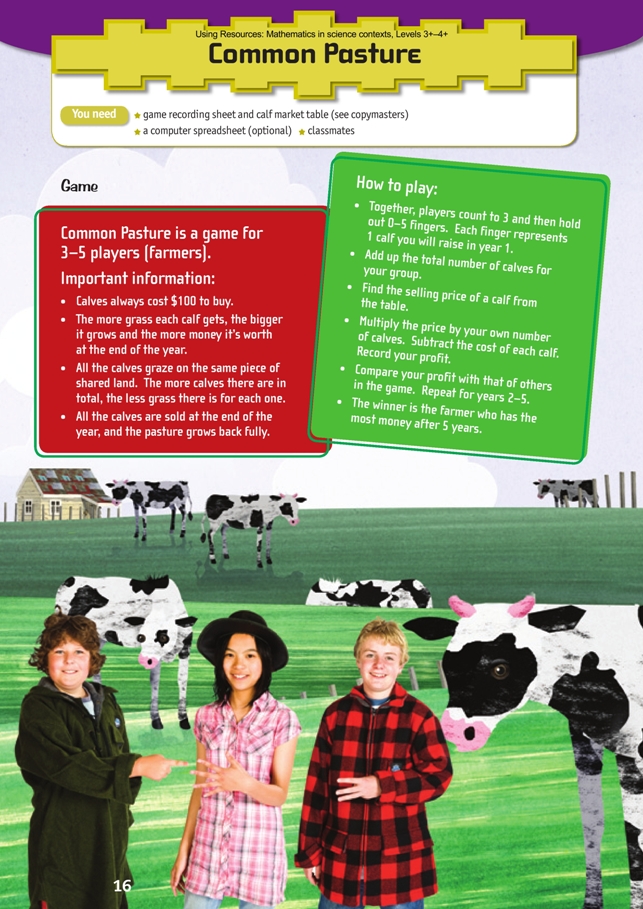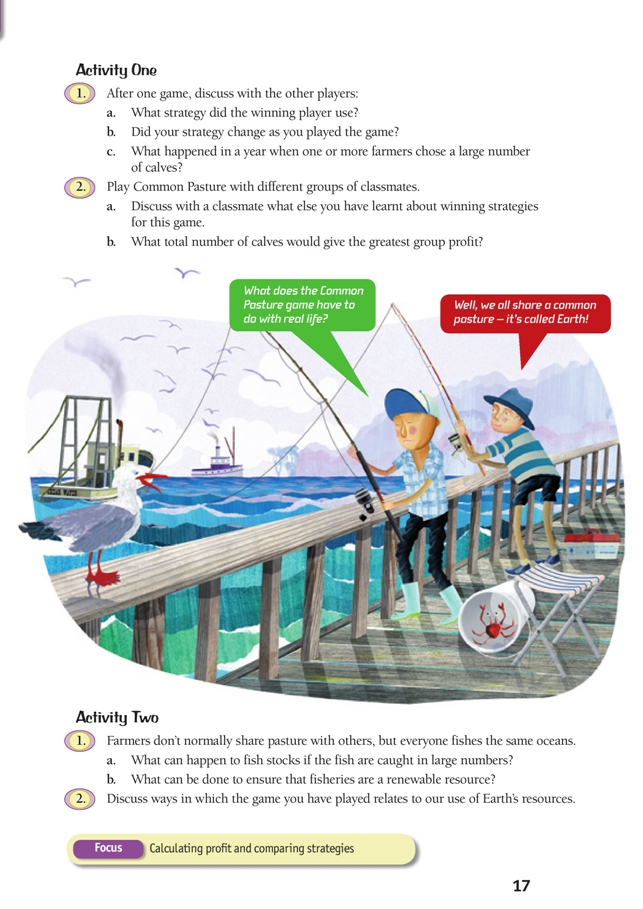This is a level (3+ to 4+) mathematics in science contexts activity from the Figure It Out series.
A PDF of the student activity is included.
Click on the image to enlarge it. Click again to close. Download PDF (1113 KB)
Students will:
- use a variety of multiplicative and additive strategies when playing the game
- use mathematical knowledge to strategise and predict how to win the game.
Students should discover that:
- social games in which one player’s actions affect everyone require multiple-move strategies and predictions such as tit-for-tat or co-operation.
a computer spreadsheet (optional)
game recording sheet and calf market table (see copymaster)
FIO, Using Resources, Levels 3+-4+, Common Pasture, pages 16 - 17
Preparation and points to note
Play the game before you introduce it to your students. There are subtleties of strategy that can make it quite competitive. For example, if one player consistently chooses to farm lots of cows, they can ruin the outcome for everyone. Establish any ground rules and expectations relating, for example, to volume and interactions (It’s just a game!). Consider asking the students to try playing the game in silence so that they can’t co-operate or collude.
For Activity One, group and regroup the students strategically so that they are exposed to a variety of examples and are asked to justify their thinking to a variety of classmates. In this way, you are deliberately making the students relate to others, the key competency in which students recognise different points of view and share ideas.
Note that 3 “farmers” are less likely to overgraze the pasture than larger groups; the game works best if they have 4, 5, or even 6 players – the students are more competitive, and the results are more varied and provide scope for more discussion.
If, in their first game, the students have trouble grasping the steps (for example, forgetting to subtract the cost of the calves), you might consider working through a few rounds of the game as a class, scoring hypothetical or random numbers of calves. In this way, the rules will become clearer to players, but it still leaves them scope to find out for themselves what happens in various scenarios. If you don’t model the game, you should go through the rules carefully and answer questions about the rules or procedures. Don’t answer questions about what will happen.
In Activity Two, the learning from the game is applied to fish stocks. Students may not understand that, like all animals, fish take time (sometimes a long time) to mature and reach breeding age. For this reason, the consequences of current fishing activity may become apparent only with the passage of time.
Points of entry: Mathematics
This game requires lots of multiplication and addition. If you decide to model the game to the whole class, you can discuss number strategies that are likely to be useful. Later, as well as asking the students what conclusions they have reached, ask them to explain how they did the mathematics. Did you, for example, subtract the cost of each calf from its selling price before multiplying, or did you calculate the profit and cost separately?
Once the students have played the game long enough for patterns and strategies to emerge, ask groups to stop and discuss what they have found. They can then share their insights with the whole class. Press for understanding: Did you discover a strategy that always worked to your advantage? Did you discover a strategy that maximised the return for the group as a whole? Under what circumstances does choosing a large number of calves turn out to be a good move? (Only if the others choose small numbers)
Different-sized groups function differently and require different strategies. For example, in a 5-player game, one player will always either make less money or cause overgrazing. Challenge the students to discover and describe these patterns and strategies.
Once the game is thoroughly understood, the students can experiment with variations designed to regulate the market and discourage unfair or excessive behaviours. For example, to investigate the effect of transfer payments, have the students play the game again, but this time if a student decides to raise no calves, the person who raises the most has to pay them $100. Ask What impact is there if sanctions are imposed on the player who overgrazes the most?
The students can also investigate the effects of both collusion and co-operation. Ask Can subgroups secretly pursue a strategy designed to shut others out of the market? You could challenge same-sized class groups to compete to create the greatest collective profit.
Those who become fascinated with this game may like to look at other classics of game theory, such as the Prisoner’s Dilemma (see Related information).
Points of entry: Science
The Tragedy of the Commons (as this activity is best known) is a much-discussed scenario that has wide application to the use of resources. It is applicable in such diverse contexts as fish stocks (as in Activity Two), traffic delays (if every vehicle slows just slightly to look at an accident, a jam soon ensues), or the Aral Sea (a textbook tragedy, see Related information).
This activity provides scope for a lot of student-generated thinking and investigation. Your role is to ensure that the connections are made between the game, limited resources, and human activity. The game models a situation in which, if people take more than their share, they gain a short-term personal advantage at the cost of others; ultimately, their unsustainable behaviour impacts on everyone. Ask your students to consider whether the game also models situations in which people “put in” instead of take out. For example, ask What if everyone were to put as much carbon dioxide as they wanted into the atmosphere? (We would reach a tipping point for climate change, just as, in the game, there is a tipping point between calf weight gain and starvation.)
This activity should lead to discussion on the general issue: How, as a nation, can we use resources responsibly while allowing people to earn a living? Discussion should also come back to the personal: So what should I do?
Answers
Game
A game of strategy
Activity One
1. a.–b. Answers will vary. In general, the way to win is to raise more calves when other players are raising fewer and to choose only a few more calves than the others so that the return per calf doesn’t fall below the profit line.
c. If most of the players chose to have lots of calves, there was not enough food to go around and all the animals lost value.
2. a. Comments will vary. Winning strategies will involve thinking about what is working and why and planning ahead. If you choose too few calves, other people can have more and you are effectively subsidising them. If everybody chooses too many calves, no one will make a profit and everybody may make a loss.
b. Based on the market table, a total of either 6 or 8 calves gives the largest payout for the group as a whole.
6 x $300 = $1,800. $1,800 – $600 = $1,200;
8 x $250 = $2,000. $2,000 – $800 = $1,200.
(For 7 calves, it’s 7 x $250 = $1,750. $1,750 – $700 = $1,050)
Activity Two
1. a. Fish stocks will be depleted if the fish are caught in large numbers. For some species, fish stocks can decline to the point where they can’t replenish themselves. Eventually, there would be no fish of that species to catch.
b. Fishermen could make sure that they don’t take more fi sh than can quickly be replaced. In New Zealand, fishermen are bound by a government quota that limits the amount of fish they can take. They can trade portions of their quota, but they can’t exceed it.
2. Discussion will vary. Points may include people only taking enough resources to cover their needs (for example, seafood such as paua), customary fishing rights, and the role, rights, and obligations of tangata whenua.

